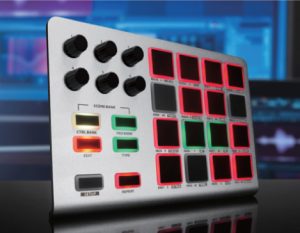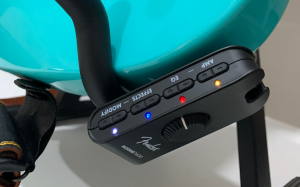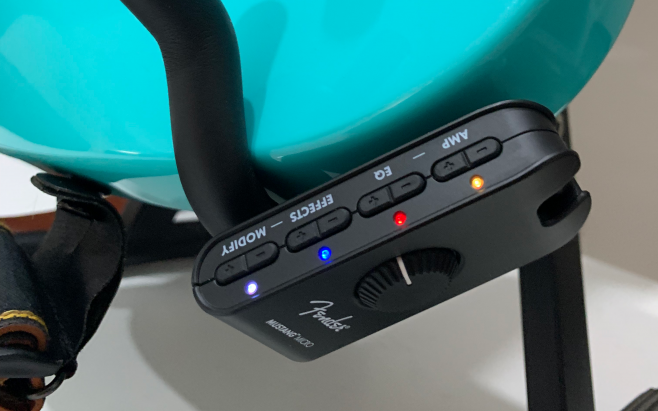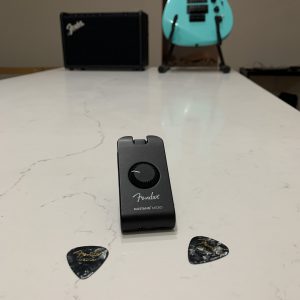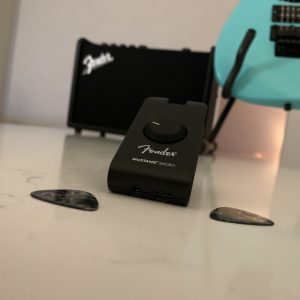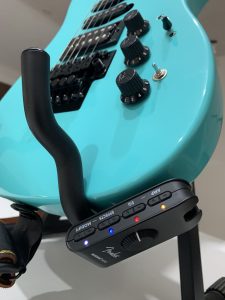Fender has been showing the music world how to effectively integrate technology into their offerings, and the Mustang Micro is no exception. Jam-packed with sonic possibilities, this tiny modeling amp bridges the gap between portability and practicality in a rechargeable, bluetooth-enabled powerhouse.
Our Verdict
Price: $119.99 USD
Pros:
- Pocket-friendly
- Rechargeable
- Bluetooth-enabled
- Great tonal options
- Affordable
Cons:
- May become your best (and only) friend during lockdown
Bottom line: The Mustang Micro is as close to a no-brainer as guitar accessories go. It’s perfect for practice and home recording, and the combination of being rechargeable, allowing for USB recording and having Bluetooth for jamming with tracks makes the Mustang Micro the best bang for a hundred bucks on the market today.
Features:
- All-in-one personal headphone amplifier with onboard DSP
- 12 amp models for a wide range of clean and dirty tones
- 12 effect combinations with parameter modify control
- Adjustable EQ
- Convenient volume control
- Bluetooth audio streaming with audio/video sync for playing along in real time
- Rechargeable lithium ion battery (charged via USB)
- 4 hours of continuous play time
- Rotating input plug for compatibility with most guitars and basses
- USB interface for recording output and firmware updates
For our full review, head past the photo…
In recent years, the music industry has seen quantum leaps forward in the integration of new technology for music creators. Robot tuners, guitars that can light up to illustrate scale patterns, and digital tuners have given way to mobile apps, modeled effects, touch interfaces and more. With all of this glittery newness, it can be easy to become distracted from why we’re buying gear in the first place: to play!
Fortunately, technology integration has matured in recent years, and some progressive companies have figured out unique and innovative ways to make tech tools that are actually a beneficial add-on to a musician’s tool belt.
Leading the charge for guitar, bass and ukulele enthusiasts, Fender has been exploring ways to continue to embrace their legendary roots while adding a number of truly useful options for players to get out of their own way, to not only play more but to play better.
Fender is, in many ways, emulating a Steve Jobs-era Apple Computers. They do this by not only developing hardware and software that builds on previous technology to better it, but they’ve also developed completely unique offerings that take musical expression to new levels of freedom.
Let’s look at a couple of examples.
In only a couple of years Fender Play has become an educational beacon to growing musicians, helping them learn their instrument on their mobile devices and desktops, and have fun doing it. Thanks to Fender Play, months of being locked in our houses became less of a drudgery and more of an opportunity to learn and improve at our instruments.
Even more recently, Fender’s growing line of Acoustasonic guitars offer players a unique instrument that’s as pick-up-and-play as an acoustic guitar, while being sonically versatile enough to take to the stage or recording studio without making any apologies. The ability to use one instrument in the role of acoustic or electric, while being as playable as any electric guitar has changed the way manufacturers around the world approach their guitar lineups, and shaped how they think about their market offerings.
In addition to these great catalysts for change, Fender’s Mustang line of modeling amps have brought options many players may not have realized they even wanted. This line of guitar amps (along with their bass amp sibling, the Rumble series) offer literally thousands of modeled amps and effects, giving players endless sound combinations. Think of them as the opposite of traditional no-holds-barred, bring-your-own-effect-pedals, high gain tube amps (for more on those, Fender Music’s EVH brand will have you covered handily).
The Mustang gives players constantly evolving sonic options through Bluetooth connectivity, an accompanying app, a bottomless supply of user generated tone models (including those generated by guitar and bass heroes), and regular software updates which essentially keeps our aging Mustangs feeling like new amps.
While the Mustang is definitely on the side of the market offering players an endless combination of tonal options and dozens of amp models, many other modeling amps have rolled out as more specialized offerings. Some popular series have seen great traction by offering lightweight amps that include the option to run on battery power, shedding the tether most guitarists deal with for amplified practice. While practical (and sounding far better than battery powered amps of yore), most of these modeling amps avoid the plethora of options of the Mustang series, offering instead individual amps for rock, blues, and other genres, each with only a handful of amp models in each.
With all of these options available, it’s even more impressive that Fender has found a gap in the market to push the industry forward.
The Device
The Mustang Micro is a truly unique device. It’s a portable modeling amp containing a dozen amp models, a dozen modifiable effects, and it’s barely larger than a couple of AA batteries.
Truly game-changing.
Walkaround
The matte black device itself is anchored on it’s face by a large master volume knob, but it’s most noticeable feature is a fold out 1/4” guitar plug. This is the Mustang Micro’s means of connecting to the instrument – it really just plugs securely into the guitar and lives there while you use it. No need to dangle the device from a strap (remember the before-it’s-time Zoom 9002?) or find a clear spot on a table.
The rounded bottom end of the Micro includes the 1/8” headphone and USB-C ports, the latter doing triple duty as charging port, firmware update port and USB out to a computer for recording. The back of the device has rubber strips to avoid marking instruments and to keep the device gripped to surfaces while disconnected from the guitar, maybe for when it’s being recharged for another round of rocking. The starboard side of the device features the power switch, and the port side has all of the amp rocker controls.
The device controls allow the player to scroll through the dozen amp models, from classics like a ’57 Twin to modern shred models like the Metal 2000. Effects include everything from different reverbs and choruses to flangers and delays. Each effect can be altered using the modify rocker buttons. The EQ can be adjusted up or down through a handful of tonal options using the EQ rocker buttons. If it sounds at all confusing, it’s really not, and to get you acclimated to the controls, Fender included a business card-sized quick reference guide.
But don’t worry – in a matter of seconds you’ll be an expert.
Plugging it in
So the usual experience is to plug the Mustang Micro into a guitar, turn it on, plug in headphones, choose an amp, adjust the EQ, select desired effects and modify them to taste. Adjust the volume and rock.
My first actual experience was weird and wonderful at the same time. I used a Limited Edition Fender HM Strat, which is a great test instrument: with an HSS configuration and a coil tap, it covers the tonal gamut from bright and thin Strat tones to thick and chunky metal tones. Additionally, the Floyd Rose trem and ultra-flat 17″ fretboard radius really make it easy to play a variety of styles.
I plugged in the Mustang Micro, set the amp to Metal 2000, and connected my iPhone up to the Mustang Micro through the phone’s Bluetooth settings. As long as it’s in range, the Mustang will show up in your phone’s available Bluetooth devices.
I quickly began playing through the tune I’m currently working on; Mr. Big’s “Alive n’ Kickin’”. By adjusting the music playback volume on the phone and the overall volume using the Micro, I found a great balance, where I might as well have been an annoying amateur guitarist playing along with Paul Gilbert in the studio. Some effect and EQ tweaks gave me the soaring lead tone I needed to truly butcher Gilbert’s mastery, but that’s no fault of the Mustang Micro. The device sounded rich and full, and amp models were real deal. None of them sound like you are using a toy or non-professional amp.
Things felt strange briefly, however. I’ve used wireless setups for guitars in the past, and I’ve used headphone-based practice setups in the past. I’ve also played along with recordings dozens of times. I’ve just never done all of it at once. I ran immediately to my neighbor’s place, who’s a far better guitarist than I am, and I shoved my earbuds at him. Although I couldn’t hear what I was playing anymore I could see the delight on his face when he realized that the guitar playing and background tracks he was hearing came from the minuscule device plugged into my Strat.
As I continued that that first jam I couldn’t believe that I could walk around the house while I play fully electrified rock into my headphones. I was playing with a recording, with a tiny device in my guitar, my phone in my pocket and some earbuds in my ear (you may want earbuds with longer cables to allow for putting the wire behind your back – I use the same Fender FXA2 in-ear monitors I record and gig with – their long cable gets up to my noggin without issue). Nothing stopped me from playing anywhere. No cables, no power cords, no bothering others, no boundaries.
Over the next few weeks I found myself playing more outside, bringing an electric guitar on cottage trips instead of an acoustic, and even leaving an inexpensive guitar in my trunk, so I could rock out while waiting to pick up my wife from work. All of a sudden there was nowhere I couldn’t make music. I was playing more because of this device.
I even throw it in my case (or pocket – it’s seriously tiny and really durable) when I pop over to my friend’s house for a quick Logic Pro or Garageband recording session. I’ve never loved the native tones in most DAWs, and the Mustang Micro is simple and I’m familiar with it, so I can plug in and go.
The freedom this little device offers is unrivaled and keeps finding new ways to impress me, but I had concerns going in.
The primary concerns I had with a rechargeable device were: 1) battery life, and 2) battery life after a zillion charges. Nobody needs more disposable electronic clutter in their lives.
As it turned out, the unit performed – and continues to perform – admirably. Fender provided a test unit for the purpose of this review, and while it had likely made a few other stops on it’s way to us, I had no problem getting at least the four hours of play time Fender claims it will achieve between charges. To be honest, I’ve been getting much closer to 6 or 6.5 hours per charge. In fact, it lasts so long that I started to forget that it needed recharging, and I always catch myself staring blankly at it whenever it does eventually conk out. Hopefully Fender releases a model with a nuclear reactor in it next time, so I can play indefinitely without the staring.
As for longevity, I’ve been playing with it for a number of weeks now and the battery life hasn’t changed discernibly over that time.
The only other point I might mention is that it’s a bit easier to change settings on the Mustang Micro using a guitar with it’s jack on the face of the guitar. The HM Strat, Teles and other bottom-plugged guitars will require a bit of neck craning, but not much; the Micro swivels in the port to reveal itself to the player. It will be interesting to see if Fender makes any changes to the plug setup with the Mustang Micro II (which I hope becomes a thing). If not, however, this one is fantastic.
So that’s it. Fender really changed the game with this fun and versatile device. Rarely does something hit the market that does something we’ve always wished possible. iPods, smart homes, touchscreens, electric cars and Mustang Micros. What a time to be alive.


